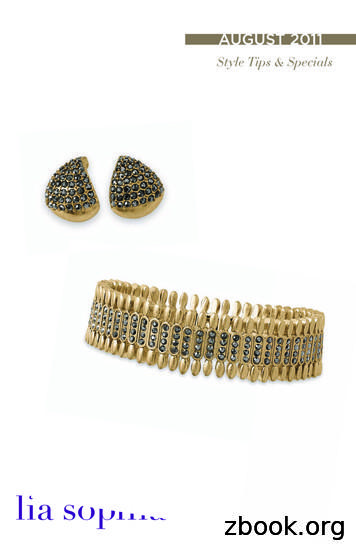Amber As Jewellery, Status Symbol And Work Of Art
STUDIA HERCYNIA XX/1, 13–18Amber as Jewellery, Status Symbol and Work of ArtJan BouzekAbstractThe paper presents a Late Archaic Italic amber head from the collections of the National Museum in Prague,with some brief notes on the amber routes, and role of amber in exchange of keimelia, wedding gifts andantidorons. The studied head is compared with stylistic particularities of heads and figurines, from fineIonian oeuvres to cruder Italic and Etruscan varieties.Key wordsAmber; trade; beads; heads and figurines.Ma chère Iva,merci enfinement pour toute l’aide amicale, pour le support essentiel dans des domaines pédagogiqueet scientifique, avec des projects, nos textes et livres communs, et notamment pour la création d’uneatmosphère d’amitié collegiale et personelle pendant les derniers 50 ans de cohabitation dans notrepetit institut de famille.Amber has always been popular. Five conferences on Amber in Archaeology have been heldand published in which I had the privilege to support my old friend Curt Beck.1 Other confer‑ences on this topic have been held recently and papers, catalogues or monographs have beenpublished or are in preparation.2 Good luck to all, who follow this path!Amber routes of the Bronze Age and the shift from eliteto individual trade enterprisesAmber routes followed those used for the distribution of other commodities: the western tinroute along the Atlantic, perhaps with the Garonne shortcut; the North ‑South Central Europe‑an route along the eastern Alps in the Late Bronze Age and later; and perhaps even the easternone, from the Baltic to the Black Sea (cf. Bouzek 1997, 122–124; Bouzek 2007). Our knowledgemay be – of course – slightly biased by the state of documentation: Amber preserves worsethan pottery or metals and can be burnt.The amber finds from the Shaft Grave in Mycenae reflected the interest of contemporaneouselites in the continent. Amber is very light, easily transportable; a single backpack may bringfortune or safeguard a way to a pilgrim. But on the Mediterranean Bronze Age shipwrecks1Liblice: Beck – Bouzek – Dreslerová eds. 1993; Forlì: Negroni Catacchio – Beck eds. 1998; Talsi: Beck –Loze – Todd eds. 2003; Beograd: Palavestra – Beck – Todd eds. 2009.2 Cf. esp. Ernée 2012 and the amber session in the Pilsen 2013 EAA Congress.
14STUDIA HERCYNIA XX/1it formed less than 1 % of the cargo. In most cases it was rather small addition to other com‑modities carried by ships, wagons or pack animals.While until the LBA amber jewellery was exclusively possessed by the top elite, from 1200BC onwards a much broader middle class might have afforded some of it. Private merchantsreplaced most of the gift exchange between rulers ca. 1000 BC in the Mediterranean.The distribution of Tiryns and Allumiere beads roughly coincides with that of late violin ‑bowand early bow fibulae; it can also be connected with the areas of the legendary Pelasgians andmay well have been part of jewellery set worn by their women (Briquel 1985; Bouzek 1997,115–118; 2007; cf. Naso 2001; Shefton 2001). The Tiryns wheel (Fig. 1) has its best parallels ineast Bohemian figure ‑of ‑eights of gold wire (Bouzek 1997, 122–124). Also in the Iron Age theamber trade concentrates mainly around the Adriatic with the prominent consumer areas inEtruria and Picenum; in Greece even its name electron underlines its high value. According tothe most probable interpretation of Herodotus IV, 33–35, amber packed in straw was broughtto Delos first by Hyperborean maidens and later sent across Illyria (cf. Bouzek 2000).Fig. 1: The Tiryns wheel, ca. 1200 BC (after Karo 1930, Beilage XXXA).Gifts, antidorons, symbol of statusAll jewellery had magic power; it represented noble women and brides. Its force tried to seducePenelope, who resisted, and Amphiaraos’ wife, who did not. It was passed down from motherto daughter, as part of a dowry in diplomatic marriages, it was kept as part of the family treas‑ury, keimelion. Amber jewels might also serve well as a gift by a lover to his fiancée, they canbe exchanged as confirmation of a treaty, and be dedicated to goddesses in their sanctuaries(cf. Bouzek – Ondřejová 2007; Ondřejová 2011).
JAN BOUZEK15Amber carving, Religion and MedicineAmber is a specific material. According to legend amber arose from the tears of Phaethon’s sis‑ters wailing at his death (Döpp 1996), and in medicine, amber was recommended in antiquityas a remedy for a number of diseases (Mülller ‑Jahncke 1996; Barfod 1996).These magical and medicinal properties of amber add a particular dimension to carvingsexecuted in it.Already the Bernstorf beads (Gebhard ‑Rieder 2002), even if disputed nowadays, withmagic signs reminding one of Linear A might have belonged to this category as well as thepuzzles on the bows of fibulae at Verucchio (Boiardi – von Eles 1994; Forte ed. 1994, Tav.IX and passim).Some of the amber carvings of the Archaic period – often dedications – depict ideal femalesand males or their faces: Aphrodite with Adonis or heroic and Dionysiac subjects (cf. the sur‑vey of Italian finds in Negroni Catacchio 1993; Losi – Raposso – Ruggiero 1993; NegroniCatacchio – Beck eds. 1998; Bonfante 2009; for the finds from the Balkans – Lisjevo pole,Novi Pazar, etc. – cf. esp. Palavestra – Krstić 2006). Other figurines, representing koboldswith some magic functions, followed the dead person as in Satricum (Fig. 2). Cut ‑off pieceswere probably kept for medical use.Fig. 2: Satricum, kobolds (?) 8th century BC (after Waarsenburg 1995).An unknown masterpieceA so far unpublished amber female head is kept in the reserves of the National Museum inPrague (Inv.no. H10-8344, H. 6.8 cm; Fig. 3, Pl. 1/1–2). It is made of dark reddish well preservedamber, carved in low relief; the rear side is flat, carved sharply with a rather broad chisel. Asusual, the carver respected the original shape of the amber lump giving the head a very highasymmetric hairdo, and added the magically starring mask ‑like face with open eyes. Even forus it expresses a kind of magical power. The female amber head has a very high hairdo or capand a hardness typical for the Etruscan and Italic Late Archaic schools.
16STUDIA HERCYNIA XX/1Fig. 3: Italic Late Archaic head, Prague Na‑tional Museum (photos: archive of theauthor).Two very close parallels from Apulian Canosa are kept in the British Museum (Figs. 4 and5; Strong 1966, 29–31, 68–70, Pl. XX:45, XXI:49), another one comes from Roccanova in Ba‑silicata (Bonfante 2009, 229, Pl. II:1). The female heads from Picenum (Marconi 1933, Fig.50, Tav. XXXI) are much cruder. The fine Getty head (Fig. 6) is later and probably Apulian, asis the earlier Eos relief and the famous representation of Aphrodite with Adonis (NegroniCatacchio 1993, Pl. X). The Ionian kouros head from Lisjevo pole is much finer (Pl. 1/3; afterPalavestra – Krstić 2006).Fig. 4: Italic Late Archaic head,British Museum (after Strong 1966).
JAN BOUZEKFig. 5: Italic Late Archaic head, British Museum(after Strong 1966).17Fig. 6: Early Classical head, Getty Museum(after Causey 1993).Unlike stones of similar colours, amber is warm, amber beads agreeable to wear as a necklaceand its magic always enhanced the feminine beauty. Let it bring good luck to the jubilee!AcknowledgmentThis article was prepared with the support of the Programme for the Development of Fieldsof Study at Charles University, No. P12 ‘History from the interdisciplinary perspective’, subprogramme ‘Society, culture and communication in Czech history’.BibliographyL’ Adriatico 2001 L’ Adriatico, i Greci e l’Europa. Atti del convegno, Venezia – Adria 2000. Anemos 2. Vicenza.Barfod, J. 1996: Bernstein in Volksglaube und Volksmedizin. In: Ganzelewski – Slotta eds. 1996, 453–456.Beck, C.W. – Bouzek, J. – Dreslerová, D. eds. 1993: Amber in Archaeology. Proceedings of the Second Inter‑national Conference Amber in Archaeology, Liblice 1990. Praha.Beck, C.W. – Loze, I.B. – Todd, J.M. eds. 2003: Amber in Archaeology. Proceedings of the Fourth InternationalConference on Amber in Archaeology, Talsi 2001. Riga.Boiardi, A. – von Eles, P. 1994: Le fibule in ambra. Appunti preliminari. In: Forte ed. 1994, 33–37.Bonfante, L. 2009: Observations on Amber Artefacts in Italy and the ‘Orientalising’ Period. In: Palavestra –Beck – Todd eds. 2009, 220–237.Bouzek, J. 1997: Greece, Anatolia and Europe. Cultural Interrelations during the Early Iron Age. SIMA 29. Jonsered.Bouzek, J. 2000: Apollon Hyperboréen, le Héros solaire et l’ âme humaine. In: P. Linant de Bellefonds (ed.):Agathos daimôn: Mythes et cultes. Etudes d’iconographie en l’honneur de Lilly Kahil. BCH Supplément 38.Paris, 57–62.Bouzek, J. 2007: The Amber Route, Apollo and the Hyperboreans. In: I. Galanaki – H. Tomas – Y. Galanakis –R. Laffineur (eds.): Between the Aegean and Baltic Seas. Proceedings of the International Conference,University of Zagreb, 11–14 April 2005. Aegaeum 27, 357–362.
18STUDIA HERCYNIA XX/1Bouzek, J. – Ondřejová, I. 2007: Götter und Göttinnen: Welche sind Unterschiede nach Geschlecht in denWeihungen. Anodos 6–7, 93–102.Briquel, D. 1985: Pélasges en Italie. Recherches sur l’histoire de la légende. Bibliothèque des Écoles françaisesd’Athènes et de Rome 252. Rome.Causey, F. 1993: Two Amber Pendants in Malibu: East Greek Craftsmanship? In: Beck – Bouzek – Dresler‑ová eds. 1993, 212–218.Döpp, S. 1996: Die Tränen Phaethons Schwestern wurden zu Bernstein. Der Phaethon ‑Mythos in OvidsMetamorphosen. In: Ganzelewski – Slotta eds. 1996, 1–8.Ernée, M. 2012: Jantar v české únětické kultuře. K počátku jantarové stezky [Bernstein in der böhmischenAunjetitz ‑Kultur. Zu den Anfängen der Bernsteinstrasse]. Památky archeologické 103, 71–172.Forte, M. ed 1994: Il dono delle Eliadi. Ambre e oreficerie dei principi etruschi di Verucchio. Catalogo della mostra,Veucchio 1994. Studi e documenti di Archeologia. Quaderni 4. Verucchio.Ganzelewski, M. – Slotta, R. eds. 1996: Bernstein. Tränen der Götter. Ausstellungskatalog, Bochum 1996.Bochum.Gebhard, R. – Rieder, K.-H. 2002: Zwei bronzezeitliche Bernsteinobjekte mit Bild- und Schriftzeichen ausBernstorf (Ldkr. Freising). Germania 80, 115–133.Karo, G. 1930: Schatz von Tiryns. Athenische Mitteilungen 55, 119–140.Losi, M. – Raposso, B. – Ruggiero, G. 1993: The Production of Amber Female Heads in Pre ‑Roman Italy. In:Beck – Bouzek – Dreslerová eds. 1993, 203–211.Marconi, P. 1933: La cultura orientalizzante nel Piceno. Monumenti antichi XXXV/3, 265–454.Müller ‑Jahncke, W.-D. 1996: Bernstein in der Medizin. In: Ganzelewski – Slotta eds. 1996, 457–464.Naso, A. 2001: Egeo, Piceno ed Europa centrale in periodo archaico. In: L’ Adriatico 2001, 81–110.Negroni Catacchio, N. 1993: The Production of Amber Figurines in Italy fom the 8th to the 4th CenturiesBC. In: Beck – Bouzek – Dreslerová eds. 1993, 191–202.Negroni Catacchio, N. – Beck, C.W. eds. 1998: Amber in Archeology. In: Atti del XIII Congresso dell’Unioneinternazionale delle scienze preistoriche e protostoriche, Workshop I/7. Forlì, 8–14 settembre 1996. Roma,371–514.Ondřejová, I. 2011: The Role of Jewellery in Ancient Societies. In: G.R. Tsetskhladze (ed.): The Black Sea, Greece,Anatolia and Europe in the First Millennium BC. Leuven – Paris – Walpole, Ma., 369–386.Palavestra, A. – Beck, C.W. – Todd, J.M. eds. 2009: Amber in Archaeology. Proceedings of the 5th InternationalConference on Amber in Archaeology, Beograd 2006. Beograd.Palavestra, A. – Krstić, V. 2006: The Magic of Amber. Beograd.Setti, B. 1996: Amber in Etruria in the 9th and 8th century B.C. In: Negroni Catacchio – Beck eds. 1998,437–443.Shefton, B.B. 2001: Adriatic Links between Aegean Greece and Iron Age Europe during the Archaic andEarly Classical Periods. Facts and some Hypotheses. In: L’ Adriatico 2001, 27–44.Strong, D. 1966: Catalogue of the Carved Amber in the Department of Greek and Roman Antiquities, British Museum. London.Waarsenburg, D.J. 1995: The Northwest Necropolis of Satricum. An Iron Age Cemetery in Latium Vetus. Amsterdam.Jan BouzekInstitute of Classical ArchaeologyFaculty of Arts, Charles University in PragueCeletná 20, CZ-11000 Prague 1jan.bouzek@ff.cuni.cz
PLATES173Pl. 1/1–2: Italic Late Archaic head, Prague National Museum (photos: archive of the author).Pl. 1/3: Archaic head ofa youth from Lisjo‑vo pole (after Pa‑lavestra – Krstić2006).
one, from the Baltic to the Black Sea (cf. Bouzek 1997, 122–124; Bouzek 2007). Our knowledge may be – of course – slightly biased by the state of documentation: Amber preserves worse than pottery or metals and can be burnt. The amber finds from the Shaft Grave in Mycenae reflected the interest of contemporaneous elites in the continent.
jewellery in India" investigated that the consumers buying behaviour also shows a shift from content to design in jewellery i.e. fashionable jewellery. 4. Berad, N. R. et al. (2015) in their study "A comparative study on the consumer's preference towards branded jewellery over non branded jewellery in Nasik city" identified the factors
Jewellery are the important part of the Indian culture. Hand jewellery specially plays very vital role in day to day lifestyle for women's. Therefore, to resolve this issue we have proposed our system, "Jewellery Try on Using AR," which will provide customers an idea of how that jewellery will look on them.
producing more than 40% of the UK jewellery output. Goldsmiths and silversmiths have been working in the area for more than 200 years, with the School of Jewellery founded in 1890. For most of its history the Jewellery Quarter was a closed community. here were no jewellery shops until the late 1970s when the economic recession prompted some of
jewellery credits. For 10 orders or more and at least two dated bookings*, receive 40% of Show sales in jewellery credits for just 15. Jewellery credits are redeemed with the purchase of regular-priced items, unless otherwise stated. HOSTESS BONUS ITEMS In addition, a Hostess is entitled to up to four jewellery items at dramatically discounted .
The Responsible Jewellery Council is the trading name of the Council for Responsible Jewellery Practices Ltd. The Council for Responsible Jewellery Practices Ltd, First Floor, Dudley House, 34‐38 Southampton Street, London, UK, WC2E 7HF.
City Zip code Phone Country Email Mobile/Cell Homepage Fax company & address Retail Wholesale . Unique jewellery Design jewellery Silver jewellery Chain and strands Rough stones Semi-precious stones Jewellery accessories Pearls
SCHOOL OF JEWELLERY 7 VITTORIA STREET Founded in 1890, the School of Jewellery is now part of Birmingham City University (BCU). It is the largest Jewellery school in Europe and ranks amongst the foremost institutions for teaching precious metalworking in the world he Atrium Gallery
Unit-1: Introduction and Classification of algae (04L) i) Prokaryotic and Eukaryotic algae ii) Classification of algae according to F. E. Fritsch (1945), G.W. Prescott and Parker (1982)























